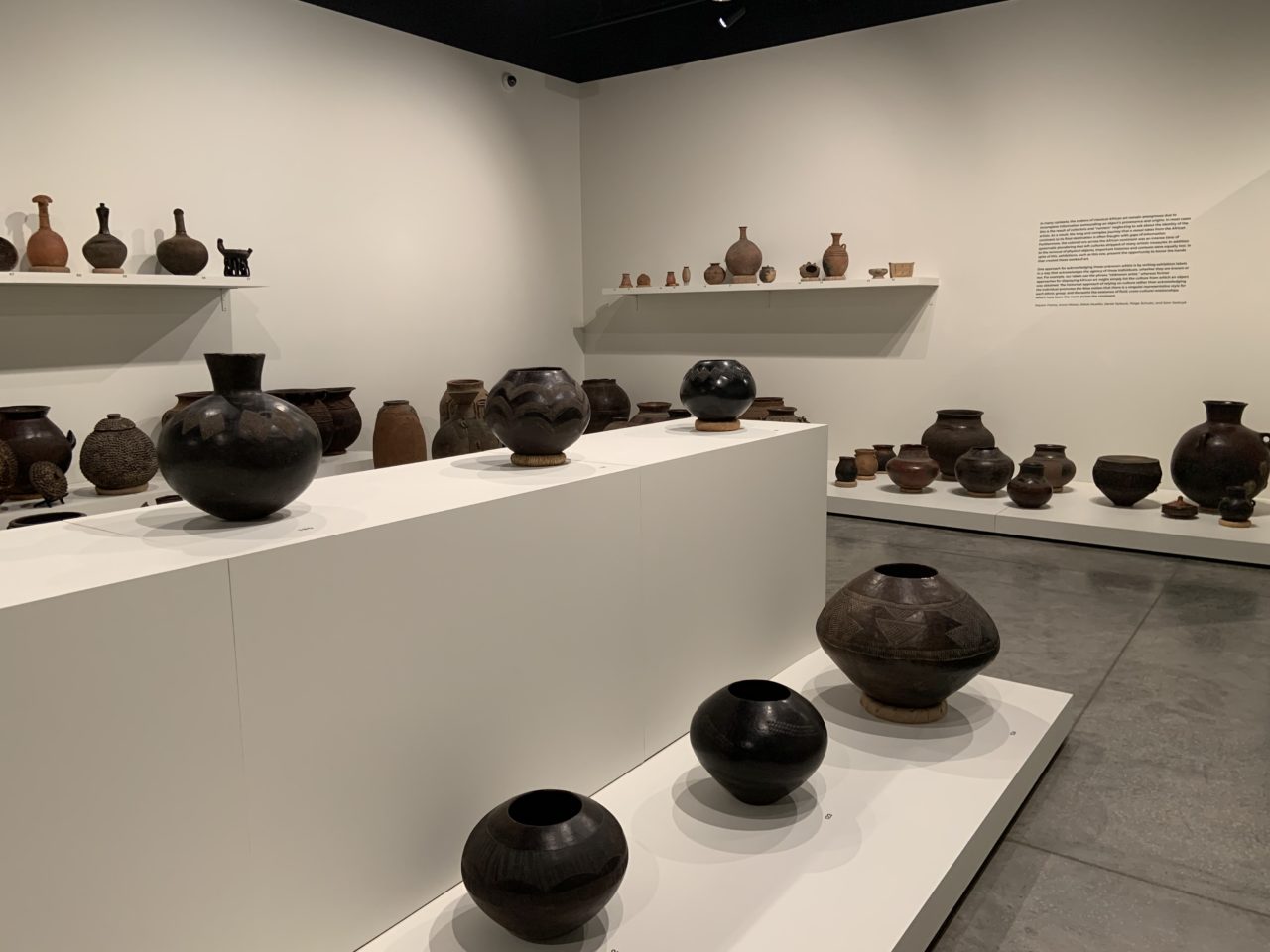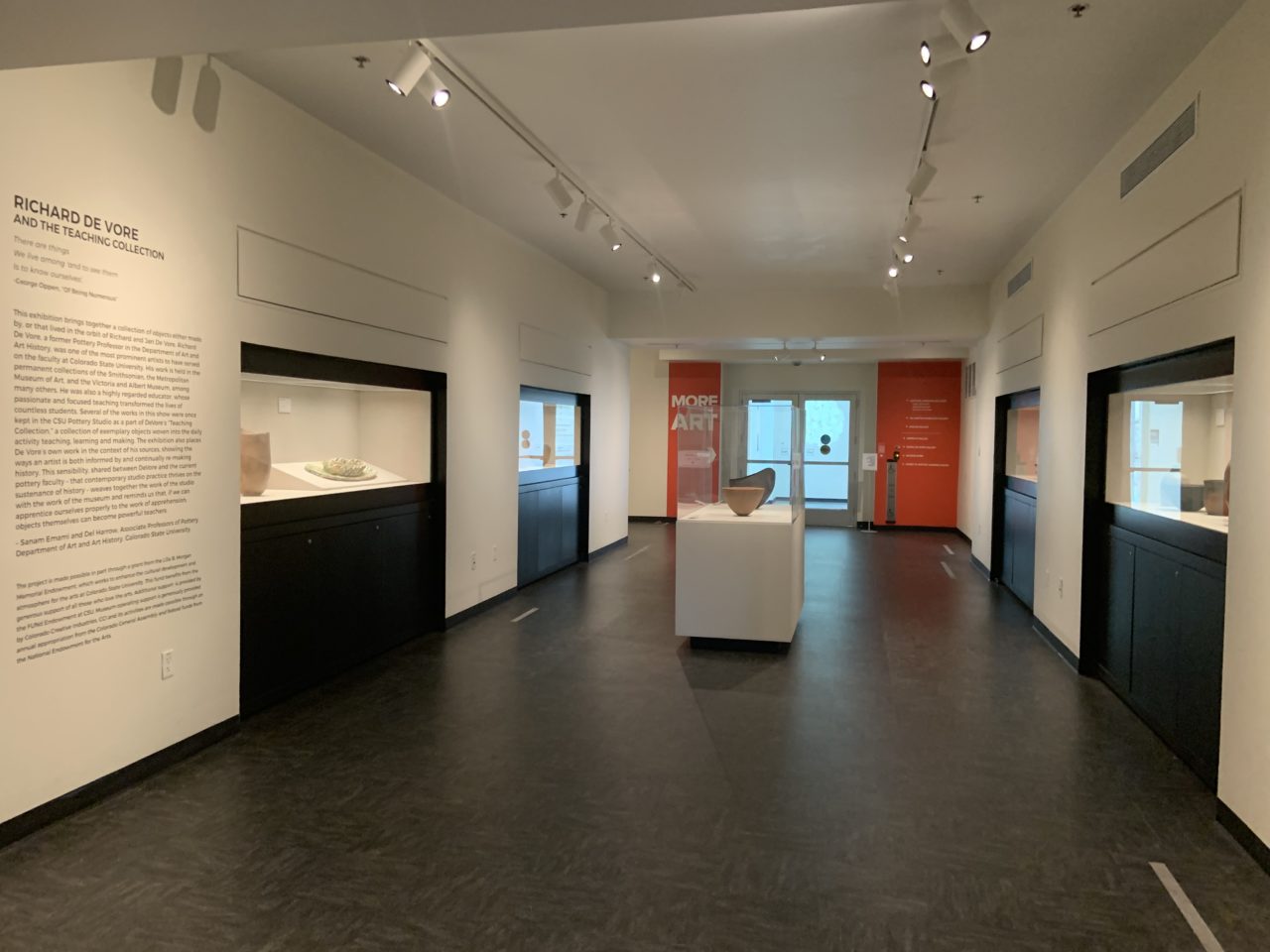The Gregory Allicar Museum of Art and Colorado State University’s Department of Art and Art History are proud to present the recordings from a virtual symposium welcoming celebrated ceramicist Dame Magdalene Odundo DBE, OBE, MA. Over a two-day period, Odundo graced CSU students, faculty, and staff with a compelling keynote lecture and lent her expertise to a panel discussion on the nature of clay in the arts.
The symposium was held in conjunction with two concurrent exhibitions at the museum—Shattering Perspectives: A Teaching Collection of African Ceramics (on view until April 25) and Richard De Vore and the Teaching Collection (on view until June 20)—and can be accessed by the public through the museum’s website and via the art department’s YouTube channel.
Odundo is a Kenyan-born British studio potter acclaimed for her hand-built ceramics, which are made with traditional hand-coiling and -burnishing techniques and without the use of a potter’s wheel. While her vessels remain intentionally unglazed, the sophisticated curves of Odundo’s clay forms recall the human body and make use of the material’s subtle, natural colors to evoke connections between earthly and sacred forms. As the artist stated in her lecture, “…the body—and particularly the female body as a carrier of life—has actually been one of my biggest muses and inspiration.”
By her own admission, the ceramicist’s practice grew slowly over time—Odundo began her career by first studying graphics and commercial art in Kenya before moving to England in 1971 to pursue design and advertising. She discovered a love for pottery during a foundation course at Cambridge School of Art and eventually began formal art training at the West Surrey College of Art in Farnham in printmaking, photography, and ceramics. In the mid-1970s, Odundo visited Nigeria and Kenya to learn traditional hand-built pottery techniques and San Ildefonso Pueblo, New Mexico to study the construction of Blackware vessels. The ceramicist later received her MA from the Royal College of Art, London in 1982.
Odundo currently lives in Farnham, Surrey and has been Chancellor of the University for the Creative Arts since 2018, where she taught from 1997–2014. The artist was awarded the African Art Recognition Award by the Detroit Art Institute in 2008, the African Heritage Outstanding Achievement in the Arts award in 2012, and a Lifetime Achievement Award from the International Ceramic Festival in 2019.
Additionally, she has received honorary doctorates from the University of Florida, Gainesville, and the University of Arts, London, and served as patron and trustee of the National Society for Education of Art and Design, UK, and on both the British Council Art Advisory Panel and the Royal College of Art Council. She is also a member of the National Museums of Kenya Nairobi’s Contemporary Art Gallery project.

Odundo’s work is represented in the permanent collections of nearly 50 international museums including the British Museum, the Art Institute of Chicago, the Metropolitan Museum of Art, and the National Museum of African Art in Washington, D.C., among others. She was also appointed Officer of the Order of the British Empire (OBE) 2008 and Dame Commander of the Order of the British Empire (DBE) in 2020 for services to art and arts education.
Against a Zoom backdrop of pixels and pottery students’ eager faces on February 12, Odundo discussed her 2019 retrospective at the Hepworth Wakefield in West Yorkshire, The Journey of Things, using the exhibition as a framework for expressing her inspirations, methodology, and philosophies. She began by tracing the influences of her personal history in developing an artistic voice, beginning with her childhood in Kenya towards the end of and after colonial British rule, and the impact of foundational art school after she moved to England in the early 1970s. There, her visits with influential studio potters Bernard Leach and Michael Cardew encouraged her to travel back throughout Africa to learn traditional pottery techniques.
Odundo initially worked in stoneware, creating pieces inspired by stylized, Nigerian sgraffito. Over time, however, she developed her own aesthetic language inspired by a variety of sources as seen in The Journey of Things: early Egyptian images, stone carvings from Oceania and elsewhere, Impressionist work by Auguste Rodin and Edgar Degas, sculptor Henry Moore’s semi-abstract modernism, El Anatsui’s dynamic sculptures, Constantin Brancusi’s impossibly smooth forms, and even the structure of Elizabethan ruffs.
“I started realizing that art has a universal language that can be understood by everybody,” Odundo told CSU students and faculty. “The history of [an] object becomes the history that I imbue in my own work.”
Throughout the discussion, Odundo repeatedly turned to the essential elements of her philosophies, primarily the concepts of “containing and un-containing” as exemplified by her work with vessels. “The vessel is at the core of my trajectory, the core of my thinking and whatever I make has to be hollow,” Odundo revealed. “I feel it’s necessary to have this inside and outside, even if it’s closed; the notion of containing and un-containing is very important.”
Afterwards, Odundo took questions from CSU students, answering queries on identity, the role of race in art and suggestions for artists of color, appropriation versus misappropriation of aesthetics, and artistic process.
On February 13, Odundo was joined by Dr. Suellen Melzer, professor of Soil Science, and Douglas Dawson, collector and gallerist, as part of a multi-disciplinary discussion on art and clay. The panel was moderated by Del Harrow and Dr. David Riep, who jointly guided Odundo, Dr. Melzer, and Dawson through a meditation on a variety of topics related to the two GAMA exhibitions: from the functions and sanctities of source material to the importance of context to the role of education in creating mindful art practice.
Shattering Perspectives: A Teaching Collection of African Ceramics is co-curated by a group of CSU art history students led by associate professor of Art History David Riep, and Richard De Vore and the Teaching Collection is curated by Pottery Area professor Sanam Emami and Del Harrow, associate professor of Art. Both exhibitions interrogate and celebrate the role of teaching collections in education; the former challenges traditional curatorial methods for discussing and displaying African art objects while the latter draws connections between disparate sources of inspiration in the late Richard De Vore’s own pottery.
The corresponding symposium was organized by Harrow, Emami, and Riep in concert with GAMA director Lynn Boland as part of the Critic and Artist Residency and the Scott Artist Lecture series. Together, the symposium and exhibitions were co-sponsored by the Lilla B. Morgan Memorial Endowment, the FUNd Endowment, and Colorado Creative Industries.
Together, Odundo and the exhibitions celebrate what the artist said of her favorite medium: “Clay is one of the few materials, really, that can capture [our] humanity.”
Both Odundo’s keynote lecture and the panel discussion can be found at the Gregory Allicar Museum of Art website: https://artmuseum.colostate.edu/events/shattering-perspectives-symposium/.


